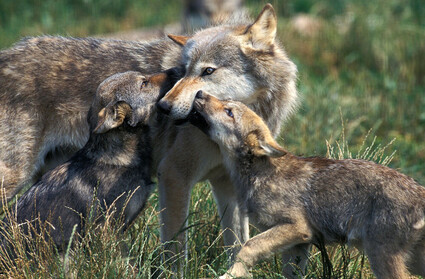Wolves: It's all in the family
Last updated 12/5/2023 at 10:41am
The topic of wolves is extremely controversial, and they are often seen as either good or bad. But no species is good or bad, as it's only we humans who classify their behavior as acceptable or not. Like any hotly debated issue, the more we understand and find similarities and commonalities, the more we can find acceptance - and in the case of the wolf, coexist.
With wolves now taking up residence in Central Oregon and dispersing through Jefferson, and Deschutes counties, this is a great time to look closer at what we have in common.
Both humans and wolves are top predators. Humans have multiple options to find food: hunting with state-of-the-art weaponry and all-terrain vehicles, hobby farms or ranches - or we can just go buy it. The wolf has its keenly developed sense for prey vulnerability, very strong jaws, the ability to run for miles, and, hopefully, its pack mates to help in coordinated hunts.
Wildlife biologists document wolves as poor hunters, with very low success rates; it is a fine line between life or death for them. Additionally, wolves, like humans, are very territorial and will fight to the death to defend their boundaries against other wolves. Hence, most wolf mortalities come from their own kind. Humans, as we know, also fight our own territorial wars.
Yet the single greatest similarity between humans and wolves is the value we hold for our family unit and the devotion and sacrifices we make for our families. Yes, a wolf is as devoted to his/her family as you or I. Wolves mate for life, only seeking out a new mate if theirs is killed. A wolf pack is a cooperative and socially dynamic unit with each member serving specific roles. Led foremost by the breeding female and her mate (formerly called the alpha female/male), wolves will only mate once a year, producing an average litter of four to six pups in mid-April. Generally, a "pack" consists of a breeding pair that has had offspring for multiple years within a designated area. However, that does not mean that all pups survive.
Survival success depends upon many factors: the size of the pack, prey availability, disease, predators, age of the breeding female, human-caused mortality and, most specifically, the contribution of pack members.
Like human families, wolf packs are made up of different members: the breeding pair or parents, yearlings or older siblings, aunts or uncles, and, in some packs, unrelated adults. All of these individuals have a responsibility to the pack and to their pups. In fact, without ancillary pack members, there is only a 30 to 60 percent chance of pups surviving their first year.
The first six weeks are critical. Newborn pups are born blind, deaf, and unable to thermoregulate. They are completely dependent upon their mom for survival and she must rely equally on her pack for food and protection, unable to leave the den except for brief trips to eliminate or to access water. Every human mom knows the challenges of a newborn (juggling family needs with her own) and appreciates the support of her partner and other family members. The more helping hands the better.
When a pack loses a contributing member, it puts the new family at greater risk. Earlier this year, the White River Pack of three near Mt. Hood lost its yearling from a car incident, and it is believed by the Oregon Department of Fish and Wildlife (ODFW) that this year's pups did not survive. In contrast, the Upper Deschutes pack, also monitored by ODFW, has seven members including two new pups. This indicates that last year's yearlings are contributing, initially by bringing food and later as babysitters allowing the more skilled adults to go off and hunt.
Depending on the location and distance of prey or a carcass, wolves have the ability to carry up to 20 pounds of food within their stomach to be regurgitated for either the pups or the nursing mom. A wolf's ability to walk up to 1,000 miles in a year is one of its super powers. The designated caretakers (either by choice or while recovering from an injury) fill invaluable roles for the youngsters, not only for protection but also for teaching life skills, like how to recognize other family members, prey, and dangers.
They also initiate games such as chase and tug-of-war. Researchers in Yellowstone National Park have observed that even the most formidable alpha male will allow rambunctious pups to attack, dog pile him, or pull his ears and tail until a restrained nip or meaningful growl is deserved. When older and at rendezvous sites, pups may go on little adventures with their sitter to practice hunting rodents while the other adult members go on more serious hunts. Life can be short for a wolf, averaging three to five years, so learning quickly how to survive is first and foremost and the family pack is key.
Like our family counterparts, wolf families thrive and survive best together as a unified, cohesive unit. From their first howl, wolves learn it's all in the family, and for the family.
















Reader Comments(0)